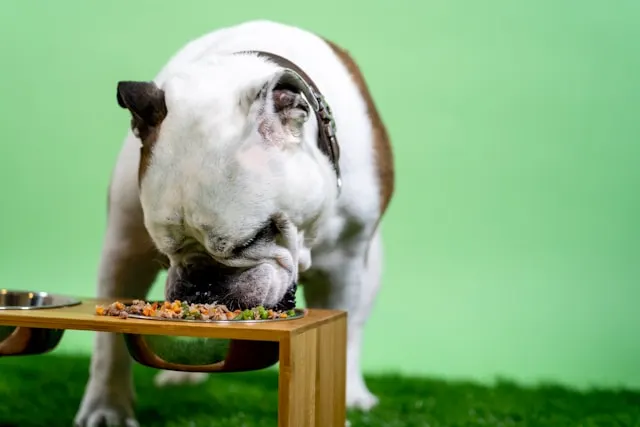It’s a scorching summer day, and you’re enjoying a juicy slice of watermelon when your dog gives you those irresistible puppy eyes. You wonder, can dogs eat watermelon too? Before sharing this refreshing fruit, it’s important to know what parts are safe and how to serve it properly.

Table of Contents
Quick Answer
Yes, dogs can eat watermelon flesh safely. This hydrating fruit is packed with vitamins A, B6, and C, plus contains lycopene and antioxidants that support canine health. Always remove seeds and rind completely before serving, as they pose choking hazards. Offer small portions (1-2 tablespoons for small dogs, ¼ cup for medium dogs) as an occasional treat.
TL;DR: Watermelon flesh is safe and healthy for dogs, but always remove seeds and rind before serving, and offer it in moderation as an occasional treat.
Why It Matters
Knowing which human foods are safe for your dog prevents unnecessary health emergencies. Watermelon, while generally beneficial, contains parts that can cause intestinal blockage or upset if not properly prepared. According to the AKC’s guide on watermelon safety for dogs, the seeds, though not toxic, can block intestinal passages if consumed in large quantities, especially in smaller breeds. The rind is difficult to digest and may cause gastrointestinal upset or obstruction. If your dog shows signs of persistent vomiting after consuming watermelon seeds or rind, see our guide on dog throwing up yellow bile. Being informed about these risks ensures you can safely share this nutritious treat with your furry friend.
Anatomy of Watermelon: Dog Safety Breakdown
Watermelon consists of three main parts, each with different implications for dog safety. The AVMA’s pet food safety guidelines recommend understanding the composition of human foods before sharing them with pets:
The Flesh: The pink, juicy part is safe and nutritious for dogs. It’s 92% water, making it an excellent hydrating treat on hot days. The flesh contains beneficial nutrients including:
- Vitamins A and C, supporting eye health and immune function
- Lycopene, a powerful antioxidant
- Potassium, important for muscle and nervous system function
- Fiber, aiding in digestion
The Seeds: Both black mature seeds and white immature seeds can pose choking hazards and potential intestinal blockages. While not toxic, they’re indigestible and problematic when consumed in quantity.
The Rind: The firm, green outer layer is too tough for dogs to digest properly. Consuming rind can lead to:
- Gastrointestinal upset, including vomiting and diarrhea
- Potential intestinal blockage requiring veterinary intervention
- Choking, especially if dogs bite off large chunks
Understanding these components helps you safely prepare watermelon for your canine companion.
Who Should Avoid Watermelon
While watermelon can be a healthy treat for most dogs, some canines should avoid it or have it strictly limited:
Dogs with Diabetes: The natural sugar content in watermelon can affect blood glucose levels. If your dog has diabetes, consult your veterinarian before offering watermelon, as they may need to adjust insulin dosing or recommend avoiding it entirely.
Dogs with Chronic Kidney Disease (CKD): Although watermelon’s high water content seems beneficial, dogs with advanced kidney disease often require carefully controlled mineral intake. The potassium in watermelon may not be suitable for dogs on kidney-specific diets. Always check with your veterinarian first.
Dogs with Sensitive Digestive Systems: Some dogs with inflammatory bowel disease or history of pancreatitis may be sensitive to any dietary changes. Introduce watermelon very cautiously if at all.
Tools & Product Recommendations
Watermelon Slicer and Server
This ergonomic watermelon tool is perfect for dog parents who regularly share this healthy treat with their pups. It effortlessly removes the flesh from the rind and creates perfectly sized, seed-free cubes that are safe for canine consumption. The stainless steel design makes quick work of even the largest melons, though you’ll need to still check for stray seeds. Yueshico Watermelon Slicer and Server.
Freezable Dog Treat Molds
Ideal for pet parents who want to create frozen watermelon treats that last. These silicone molds come in various sizes for different dog breeds and feature paw-shaped designs perfect for creating frozen watermelon puree treats. They’re dishwasher safe and BPA-free, though they require freezer space and advance preparation. Dog Treat Molds for Baking and Freezing.
Portable Dog Water Bottle with Treat Storage
Perfect for active dog families, this bottle keeps your pup hydrated on walks while the attached compartment stores small watermelon chunks. The leak-proof design prevents messes in your bag, and the built-in dispenser allows easy sharing during outdoor adventures. The only limitation is the small treat storage capacity for larger dogs. Dog Water Bottle with Food Container.
Premium Stainless Steel Dog Bowl
Double-wall stainless with a non-slip base keeps seedless watermelon cubes colder longer and won’t tip when excited eaters crowd the bowl—perfect for patios and large breeds. Dishwasher-safe and odor-resistant. YETI Boomer 8 Stainless Steel Dog Bowl .
Step-by-Step Tutorial: How to Serve Watermelon to Dogs
- Select a ripe, fresh watermelon. Look for a deep, hollow sound when thumped and a creamy yellow (not white) spot where it sat on the ground.
- Wash the watermelon thoroughly to remove any pesticides or contaminants from the surface.
- Cut the watermelon in half, then into manageable sections using a sharp knife on a stable cutting surface.
- Remove all seeds from the flesh. Even seedless varieties may contain small white immature seeds that should be removed for smaller dogs.
- Cut away the rind completely, ensuring no green or white parts remain attached to the pink flesh.
- Dice the seedless flesh into appropriately sized cubes based on your dog’s size (see Sizing Guide below).
- Serve at room temperature or slightly chilled – extremely cold treats can shock your dog’s system or cause brain freeze.
- Start with a small amount (1-2 pieces) to ensure your dog tolerates watermelon well, especially if it’s their first time.
- Monitor your dog after eating for any signs of digestive upset or allergic reaction.
- Store any unused watermelon pieces in an airtight container in the refrigerator for up to two days.
Fresh vs Frozen vs Pureed: Quick Comparison
Fresh Watermelon Chunks
- Pros: Maximum hydration, natural texture, minimal preparation, retains full nutritional profile
- Cons: Shortest shelf life, potential mess on floors/furniture, requires immediate consumption
Frozen Watermelon Pieces
- Pros: Longer-lasting treat, extra refreshing in summer, helps soothe teething puppies, reduces mess
- Cons: Too hard for some dogs’ teeth, potential for brain freeze, slightly altered texture when thawed
Pureed Watermelon
- Pros: Easiest to digest, can be mixed with other dog-safe fruits, good for senior dogs or those with dental issues
- Cons: Higher preparation effort, may be too high in sugar when concentrated, potential for more mess
Portion Guide by Breed Size
Small Breeds (under 20 lbs – Chihuahua, Yorkie, Maltese)
- 1-2 tablespoons (15-30g) of diced watermelon (½-inch cubes)
- Maximum of 2-3 small pieces per serving
- Limit to 1-2 times weekly
Medium Breeds (20-50 lbs – Beagle, Cocker Spaniel, Bulldog)
- ¼ cup (about 40g) of diced watermelon (1-inch cubes)
- Maximum of 4-5 medium pieces per serving
- Limit to 2-3 times weekly
Large Breeds (50-90 lbs – Labrador, German Shepherd, Boxer)
- ⅓-½ cup (50-75g) of diced watermelon (1-inch cubes)
- Maximum of 6-8 pieces per serving
- Limit to 2-3 times weekly
Giant Breeds (over 90 lbs – Great Dane, Saint Bernard, Mastiff)
- ½-¾ cup (75-110g) of diced watermelon (1-inch cubes)
- Maximum of 10-12 pieces per serving
- Limit to 2-3 times weekly
Watermelon ≈ 30 kcal per 100g; count it in your 10% daily-treat limit.
Common Mistakes (and Fixes)
Leaving seeds in the watermelon. The fix: Cut the watermelon in half and carefully remove all black and white seeds with a fork or spoon before serving.
Including pieces of rind. The fix: Cut well away from the rind, ensuring only the pink flesh remains, with no white or green portions attached.
Offering too much at once. The fix: Follow the portion guide above and limit watermelon to 10% or less of your dog’s daily food intake.
Serving frozen watermelon to dogs with sensitive teeth. The fix: Allow frozen pieces to thaw for 5-10 minutes before serving, or offer pureed watermelon instead.
Adding salt, sugar, or other seasonings. The fix: Serve watermelon plain – dogs enjoy the natural flavor and don’t need added ingredients that might be harmful.
Allowing unlimited access to watermelon. The fix: Treat watermelon as an occasional treat, not a regular part of the diet, to prevent digestive upset or obesity.
Ignoring individual sensitivities. The fix: Introduce watermelon gradually and watch for signs of intolerance like soft stool or gas before offering more.
Troubleshooting (If/Then)
If your dog has diarrhea after eating watermelon, then reduce the portion size or frequency, or discontinue offering it completely.
If your dog seems constipated after watermelon, then ensure you’re removing all seeds and rind, and consider reducing the amount.
If your dog picks around the watermelon in their bowl, then try freezing small pieces or mixing with a small amount of plain yogurt to enhance appeal.
If your dog seems excessively thirsty after eating watermelon, then reduce the portion size, as the natural sugars might be triggering increased thirst.
If your puppy is teething and loves watermelon, then freeze small pieces for a soothing, hydrating teething aid (but monitor closely).
If your dog has diabetes, then consult your veterinarian before offering watermelon, as the natural sugars may affect blood glucose levels.
If your dog gulps watermelon without chewing, then freeze small pieces to force slower consumption or puree and serve in a slow-feeder bowl.
When to See a Professional
Contact your veterinarian immediately if you notice:
- Vomiting or diarrhea persisting for more than 24 hours after watermelon consumption
- Signs of intestinal blockage: repeated vomiting, abdominal pain, hunched posture, or lack of appetite
- Difficulty breathing or excessive drooling (potential allergic reaction)
- Lethargy or significant behavior changes following watermelon consumption
- Straining during defecation, especially if you suspect seed consumption
- Blood in vomit or stool after eating watermelon
FAQs
Can dogs eat watermelon seeds? No, dogs should not eat watermelon seeds. While not toxic, the seeds can cause intestinal blockage, particularly in small breeds. Always remove all black and white seeds before serving watermelon to your dog.
Can dogs eat watermelon rind? Dogs should not eat watermelon rind. The tough, green outer layer is difficult to digest and can cause gastrointestinal upset or blockage. Only the pink flesh is safe for canine consumption.
How much watermelon can I give my dog? Watermelon should be an occasional treat, not exceeding 10% of your dog’s daily caloric intake. Small dogs can have 1-2 tablespoons, medium dogs ¼ cup, and large dogs ⅓-½ cup. Always introduce new foods gradually.
Is watermelon good for dogs with kidney disease? Watermelon’s high water content can be beneficial for dogs with kidney disease, but always consult your veterinarian first. The natural sugars and potassium content may affect some kidney conditions differently.
Can puppies eat watermelon? Yes, puppies can eat small amounts of seedless, rind-free watermelon flesh. Start with tiny portions and monitor for digestive upset. Frozen watermelon pieces can also soothe teething discomfort.
What other fruits are safe for dogs? Dogs can safely enjoy moderate amounts of apples (without seeds), blueberries, strawberries, and bananas. Avoid grapes, raisins, cherries, and citrus fruits, which can be toxic or cause digestive issues.
Does watermelon help keep dogs hydrated? Yes, with 92% water content, watermelon can contribute to hydration, especially during hot weather. However, it should supplement, not replace, fresh drinking water.
Conclusion
Watermelon can be a healthy, hydrating treat for your dog when served properly. By removing seeds and rind, controlling portions, and monitoring your dog’s individual response, you can safely share this nutritious summer fruit with your furry friend. Remember that even healthy treats like watermelon should make up no more than 10% of your dog’s diet to maintain balanced nutrition. Next time you’re enjoying this juicy treat on a hot day, feel free to share some prepared watermelon with your pup—their wagging tail will thank you! Consider exploring other safe fruits for dogs to add variety to their treat rotation, always introducing new foods gradually and in moderation.
Medical Disclaimer: This article is for informational purposes only and is not intended to replace professional veterinary advice. Always consult with your veterinarian before introducing new foods to your dog’s diet, especially if they have existing health conditions.

